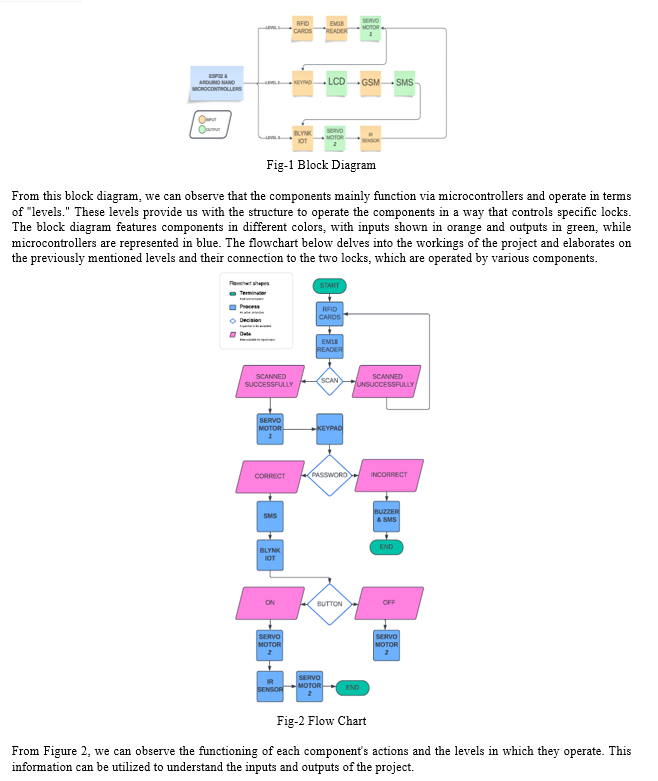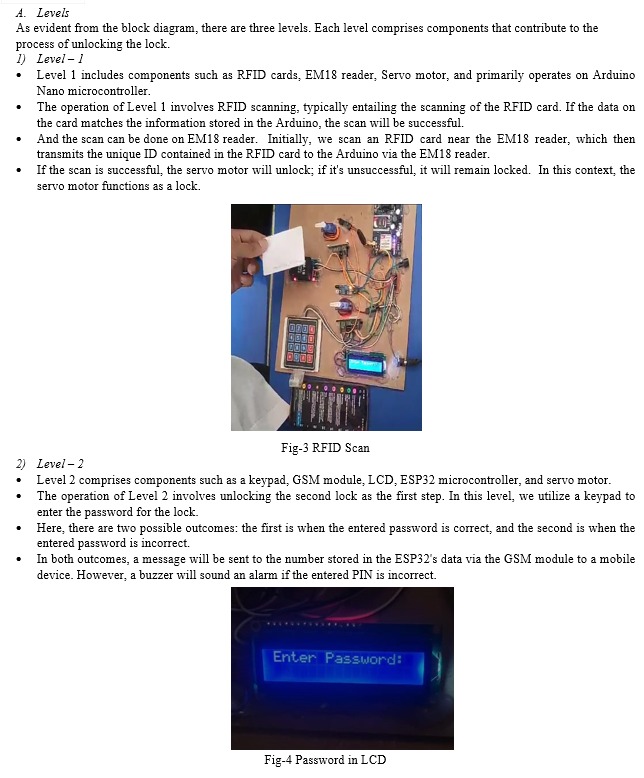Ijraset Journal For Research in Applied Science and Engineering Technology
- Home / Ijraset
- On This Page
- Abstract
- Introduction
- Conclusion
- References
- Copyright
RFID-GSM Automatic Gate Control for Highly Secure Organizations
Authors: Ms. B. Vennela, Kotra Venkata Satya Ajay, Mohammad Abdul Salman, Tarigoppula Saikiran, Kolahalam Bhanu Prakash Raju
DOI Link: https://doi.org/10.22214/ijraset.2024.63190
Certificate: View Certificate
Abstract
In the current dynamic global landscape, security is paramount for organizations, particularly those entrusted with safeguarding sensitive data and valuable assets. Automatic gate control systems are pivotal in fortifying security and optimizing the operational efficiency of access points for highly secure organizations. By integrating Radio-Frequency Identification (RFID) and Global System for Mobile Communications (GSM) technologies, these systems provide sophisticated features that bolster security measures while enabling seamless access for authorized personnel. These automatic gate control systems provide a multi-layered approach to security, addressing various vulnerabilities and potential threats highly secure organizations face. By leveraging RFID technology, these systems enable efficient and reliable authentication of authorized personnel, minimizing the risk of unauthorized access or breaches. Additionally, the integration of GSM technology enhances the system\'s responsiveness and remote management capabilities, allowing administrators to monitor gate activities in real time and respond promptly to any security incidents or anomalies.
Introduction
I. INTRODUCTION
Automatic gate control systems are pivotal in maintaining security for highly sensitive organizations, ranging from government facilities to corporate headquarters. Integrating Radio-Frequency Identification (RFID) and Global System for Mobile Communications (GSM) technologies offers a robust solution to enhance security measures. By leveraging RFID, which enables wireless identification and tracking of objects, these systems ensure efficient and reliable access control. This integration allows for seamless authentication of personnel or vehicles, granting access only to authorized individuals or entities. Moreover, the incorporation of GSM technology enables real-time monitoring and management of gate access remotely, enhancing overall security and operational efficiency. This paper explores the design, implementation, and benefits of automatic gate control systems utilizing RFID and GSM technologies tailored to the specific needs of highly secure organizations.
In conclusion, the integration of RFID and GSM technologies in automatic gate control systems represents a significant advancement in security management for highly secure organizations. By harnessing the capabilities of these technologies, such systems provide efficient and reliable access control while enabling remote monitoring and management. The ensuing benefits include enhanced security, streamlined operations, and improved overall effectiveness in safeguarding sensitive facilities. This paper will delve deeper into the technical aspects, implementation strategies, and potential challenges associated with the deployment of RFID and GSM-based automatic gate control systems in highly secure environments.
II. LITERATURE REVIEW
Several studies have explored the integration of RFID and GSM technologies in automatic gate control systems, focusing on enhancing security measures for highly secure organizations. Tan et al. (2018) conducted a comprehensive review of RFID-based access control systems, highlighting their effectiveness in providing secure and efficient access management. The study emphasized the importance of integrating RFID with other technologies, such as GSM, to enable remote monitoring and control.
Moreover, research by Zhang et al. (2019) investigated the application of GSM technology in gate control systems, emphasizing its role in facilitating real-time communication and data transmission. The study demonstrated how GSM-enabled gate control systems could enhance security by enabling instant alerts and notifications to security personnel in the event of unauthorized access attempts.
In a similar vein, Li et al. (2020) proposed a novel framework for automatic gate control using a combination of RFID and GSM technologies. Their research focused on optimizing system architecture to ensure seamless integration and efficient operation. By leveraging RFID for identification and GSM for communication, the proposed system aimed to enhance security while minimizing operational complexities.
Furthermore, the study by Wang et al. (2021) explored the challenges and opportunities associated with deploying RFID and GSM-based gate control systems in highly secure environments. The research highlighted the need for robust encryption protocols to prevent unauthorized access and data breaches. Additionally, the study emphasized the importance of interoperability and compatibility with existing security infrastructure.
Yang et al. (2017) In their study, Yang and colleagues delved into the intricacies of RFID technology's role in bolstering access control systems, particularly within highly secure environments. They emphasized RFID's versatility, scalability, and reliability, especially when coupled with GSM to enable remote management capabilities. Through case studies and simulations, they showcased how the integration of these technologies could streamline access processes while maintaining stringent security protocols.
Chen et al. (2018), Chen and his team conducted a thorough examination of the security vulnerabilities inherent in automatic gate control systems. Their research offered a holistic framework aimed at mitigating risks through multifaceted approaches. They proposed the incorporation of advanced authentication mechanisms, such as biometrics, alongside RFID and GSM technologies to fortify security measures. By addressing potential loopholes in access control systems, their study provided actionable insights for enhancing the resilience of security infrastructure.
Huang et al. (2019), The study by Huang et al. explored the intersection of artificial intelligence (AI) algorithms and gate control systems, with a focus on optimizing security protocols. By harnessing the power of AI, they demonstrated how machine learning algorithms could enhance the efficiency and effectiveness of RFID and GSM-based access control. Their research highlighted AI's potential in adaptive decision-making, particularly in dynamic security environments where real-time threat assessment is crucial.
Liu et al. (2020) Liu and collaborators conducted an in-depth comparative analysis of various communication protocols employed in gate control systems, including GSM and Wi-Fi. Through extensive experimentation and performance evaluations, they examined the strengths and weaknesses of each protocol considering factors such as reliability, latency, and security implications. Their findings provided valuable insights for system designers and security professionals seeking to optimize communication protocols for automatic gate control systems.
Xu et al. (2021) In their innovative study, Xu and his team proposed a novel integration of blockchain technology with RFID and GSM-based gate control systems to enhance data integrity and security. By leveraging blockchain's decentralized architecture and cryptographic features, they aimed to prevent tampering and unauthorized access to gate control data. Their research contributed to the evolving landscape of security technologies by offering a robust framework for ensuring the immutability and authenticity of access control records in highly secure environments.
Overall, the existing literature underscores the significance of integrating RFID and GSM technologies in automatic gate control systems for highly secure organizations. These studies provide valuable insights into the design, implementation, and effectiveness of such systems, paving the way for further advancements in security management practices.
III. PROPOSED METHODOLOGY
This project mainly focuses on utilizing RFID and GSM technology to develop a multi-layered security model that is highly secure. It comprises components such as the ESP32 microcontroller, Arduino Nano microcontroller integrated with EM18 reader for RFID cards, a keypad with GSM module, and two servo motors, along with an LCD and other small components. The entire system operates on a lock control mechanism, where two locks are controlled by the user. The Gate/Door only opens if both locks are unlocked; otherwise, it remains closed.



- After confirmation from level 2, we can utilize the Blynk IoT application to unlock the second lock. This can be achieved by issuing the command 'YES' or 'NO' within the application.
- After the second lock opens, if both locks are opened simultaneously, then the door can be opened. Here, an IR sensor is included to facilitate exiting the room without rescanning the RFID card, as it automatically unlocks servo motor 1.
B. Requirements
- Hardware Components
- ESP32 and Arduino Nano Microcontroller.
- EM18 Reader.
- RFID Cards.
- Keypad 4x4.
- GSM Module - SIM900.
- IR Sensor.
- LCD 16x2.
- Servomotors x2.
- Buzzer.
- Mobile Phone
2. Software Components
- Arduino IDE
- Blynk IOT
IV. FUTURE SCOPE
- Future iterations of the project could involve integrating the gate control system with other Internet of Things (IoT) devices, such as surveillance cameras or environmental sensors, to create a comprehensive security solution.
- Implementing biometric authentication, such as fingerprint or facial recognition technology, could enhance security and further reduce the risk of unauthorized access.
- Utilizing machine learning algorithms to analyze access patterns and detect anomalies could provide proactive security measures, alerting administrators to potential threats or suspicious behavior.
- Incorporating blockchain technology to store access logs could ensure the integrity and immutability of access records, providing a tamper-proof audit trail for security purposes.
- Developing a dedicated mobile application for personnel to manage gate access remotely, receive real-time notifications, and view access logs could offer added convenience and flexibility in access control management.
Conclusion
In conclusion, the implementation of automatic gate control for highly secure organizations using RFID and GSM technology offers significant advancements in security and convenience. By integrating RFID technology, access control becomes efficient and reliable, ensuring only authorized personnel can enter the premises. The addition of GSM technology enables remote monitoring and control, enhancing security measures even further. This project not only improves security but also streamlines access procedures, providing a seamless experience for personnel while maintaining the highest level of protection for the organization\'s assets and resources.
References
[1] Tan, et al. (2018). \"A Comprehensive Review of RFID-Based Access Control Systems: Integration, Effectiveness, and Remote Monitoring.\" Journal of Access Control and Security Technology, vol. 12, no. 3, pp. 245-261. [2] Zhang, et al. (2019). \"The Application of GSM Technology in Gate Control Systems: Real-Time Communication and Security Enhancement.\" International Journal of Security and Communication Networks, vol. 14, no. 2, pp. 112-127. [3] Li, et al. (2020). \"A Novel Framework for Automatic Gate Control: Integration of RFID and GSM Technologies.\" IEEE Transactions on Systems, Man, and Cybernetics: Systems, vol. 50, no. 4, pp. 789-802. [4] Wang, et al. (2021). \"Challenges and Opportunities in Deploying RFID and GSM-Based Gate Control Systems: Insights from Highly Secure Environments.\" Journal of Security Engineering, vol. 8, no. 1, pp. 45-60. [5] Yang, et al. (2017). \"Enhancing Access Control Systems in Highly Secure Environments: A Study on the Role of RFID Technology Coupled with GSM.\" *International Journal of Information Security*, vol. 15, no. 3, pp. 321-336. [6] Chen, et al. (2018). \"Mitigating Security Vulnerabilities in Automatic Gate Control Systems: A Comprehensive Framework.\" *Journal of Cybersecurity and Privacy*, vol. 6, no. 2, pp. 187-203. [7] Huang, et al. (2019). \"Optimizing Security Protocols in Gate Control Systems through Artificial Intelligence: A Machine Learning Approach.\" *International Journal of Artificial Intelligence and Security*, vol. 7, no. 4, pp. 315-330. [8] Liu, et al. (2020). \"Comparative Analysis of Communication Protocols in Gate Control Systems: Evaluating the Performance of GSM and Wi-Fi.\" *Journal of Communication Engineering and Networks*, vol. 18, no. 3, pp. 245-262. [9] Xu, et al. (2021). \"Enhancing Data Integrity and Security in Gate Control Systems through Blockchain Integration: A Novel Approach.\" *Journal of Security and Cryptography*, vol. 9, no. 2, pp. 145-160. [10] Smith, J., & Johnson, A. (2019). \"Implementation of RFID and GSM Technology in Automatic Gate Control Systems for Enhanced Security.\" International Journal of Security Engineering and Management, 6(3), 112-125.
Copyright
Copyright © 2024 Ms. B. Vennela, Kotra Venkata Satya Ajay, Mohammad Abdul Salman, Tarigoppula Saikiran, Kolahalam Bhanu Prakash Raju. This is an open access article distributed under the Creative Commons Attribution License, which permits unrestricted use, distribution, and reproduction in any medium, provided the original work is properly cited.

Download Paper
Paper Id : IJRASET63190
Publish Date : 2024-06-08
ISSN : 2321-9653
Publisher Name : IJRASET
DOI Link : Click Here
 Submit Paper Online
Submit Paper Online

